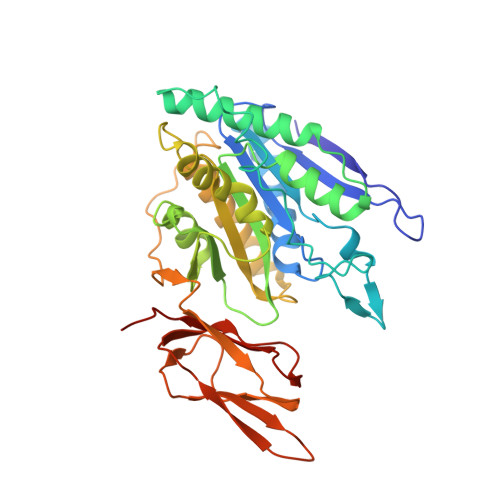Discovery of cyanophycin dipeptide hydrolase enzymes suggests widespread utility of the natural biopolymer cyanophycin.
Sharon, I., McKay, G.A., Nguyen, D., Schmeing, T.M.(2023) Proc Natl Acad Sci U S A 120: e2216547120-e2216547120
- PubMed: 36800389
- DOI: https://doi.org/10.1073/pnas.2216547120
- Primary Citation of Related Structures:
8EIN, 8EIP - PubMed Abstract:
Cyanophycin is a bacterial polymer mainly used for nitrogen storage. It is composed of a peptide backbone of L-aspartate residues with L-arginines attached to their side chains through isopeptide bonds. Cyanophycin is degraded in two steps: Cyanophycinase cleaves the polymer into β-Asp-Arg dipeptides, which are hydrolyzed into free Asp and Arg by enzymes possessing isoaspartyl dipeptide hydrolase activity. Two unrelated enzymes with this activity, isoaspartyl dipeptidase (IadA) and isoaspartyl aminopeptidase (IaaA) have been shown to degrade β-Asp-Arg dipeptides, but bacteria which encode cyanophycin-metabolizing genes can lack iaaA and iadA genes. In this study, we investigate a previously uncharacterized enzyme whose gene can cluster with cyanophycin-metabolizing genes. This enzyme, which we name cyanophycin dipeptide hydrolase (CphZ), is specific for dipeptides derived from cyanophycin degradation. Accordingly, a co-complex structure of CphZ and β-Asp-Arg shows that CphZ, unlike IadA or IaaA, recognizes all portions of its β-Asp-Arg substrate. Bioinformatic analyses showed that CphZ is found in very many proteobacteria and is homologous to an uncharacterized protein encoded in the "arginine/ornithine transport" (aot) operon of many pseudomonas species, including Pseudomonas aeruginosa . In vitro assays show that AotO is indeed a CphZ, and in cellulo growth experiments show that this enzyme and the aot operon allow P. aeruginosa to take up and use β-Asp-Arg as a sole carbon and nitrogen source. Together the results establish the novel, highly specific enzyme subfamily of CphZs, suggesting that cyanophycin is potentially used by a much wider range of bacteria than previously appreciated.
- Department of Biochemistry, McGill University, Montréal, QC H3G 0B1, Canada.
Organizational Affiliation:


















